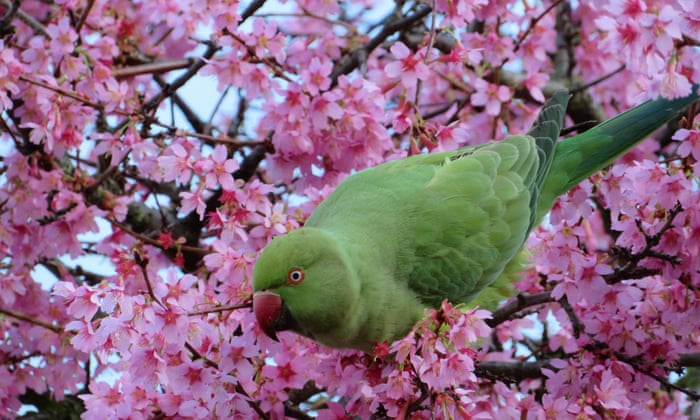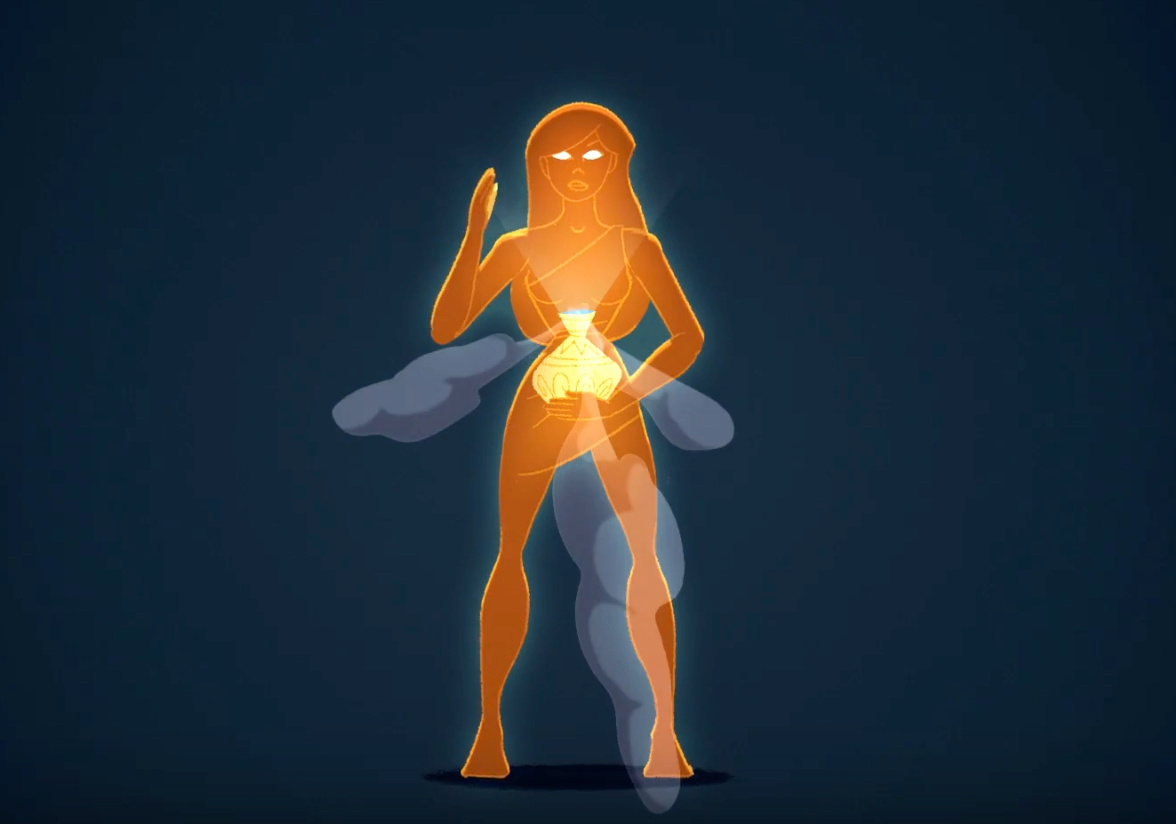via Boing Boing by Mark Frauenfelder
As a kid I set my friend's kitchen on fire melting potassium nitrate and sugar on the stove, so be careful when making these cool colored smoke bombs, which use oil pastels as pigment.
==============================
The great green expansion: how ring-necked parakeets took over London
via the Guardian by Nick Hunt

A parakeet in blossoming trees near Victoria Park. Photograph: Courtney Hopf
Was Jimi Hendrix responsible for the bright-green tropical birds’ presence in the capital? Or was it Katharine Hepburn?
Electric Ladyland wasn’t the only thing Jimi Hendrix released in 1968. One day in that tumultuous year he left his flat on Brook Street, Mayfair, and strolled down nearby Carnaby Street with a birdcage in his hands. I like to think that he was dressed in a tasselled jacket and flares, his favourite Fender Stratocaster slung across his back. Or perhaps he travelled incognito, in a trenchcoat and dark glasses. Either way, somewhere on that street, the heart of Swinging London at the height of peace and love, he opened the door of the cage and unleashed two bright green birds: Adam and Eve, a breeding pair of ring-necked parakeets.
Continue reading
==============================
Timothy O’Sullivan and the Shoshone Falls
via Picture This (Library of Congress Pictures and Photos by Kristi Finefield![Mr. Sullivan [i.e. O'Sullivan]. Photo by Wheeler & Angerman, circa 1873. //hdl.loc.gov/loc.pnp/ppmsca.31600](https://blogs.loc.gov/picturethis/files/2019/03/31600r.jpg)
Details about the life of Irish American photographer Timothy O’Sullivan are sparse. He was either born in New York or emigrated with his parents at the age of 2 from Ireland in 1842. He died at the age of 42 from tuberculosis. He left few documents in his own hand, but the photographs he took during his relatively short life speak volumes.O’Sullivan worked for Mathew Brady and with Alexander Gardner documenting the U.S. Civil War as a photographer in the field. His photographs populate just under half the pages of Gardner’s landmark work, the Photographic Sketch Book of the War. After the war, O’Sullivan would spend years traveling as the photographer for geographical and geological surveys as the U.S. government sought to document parts of the vast western part of the continent.Continue reading and see some superb photographs.
==============================
When a river is dammed, is it damned forever?
via the OUP blog by Jeff Duda, Ryan Bellmore and George Pessmarch Glines Canyon Dam and Lake Mills post dam removal. CC0 via U.S. Geological Survey.Since the dawn of advanced civilizations, humanity has sought to manage the flow of rive. Protection from floods, water for drinking and irrigating crops, and extraction of resources like food and energy are among the most popular reasons for building dams. Early successes in controlling the flow of rivers for society’s benefit led to more construction, reaching the point that in Europe and North America today most prime locations for placing dams have been taken. Additionally, many large river systems in the developed world have at least one but often multiple dams on them. Estimates suggest that water in reservoirs has increased the world’s lake environments by nearly ten percent. In parts of the developing world, new dam construction is now booming as well, as emerging economies try to make up for lost time.Continue reading
Glines Canyon Dam and Lake Mills post dam removal. CC0 via U.S. Geological Survey.Since the dawn of advanced civilizations, humanity has sought to manage the flow of rive. Protection from floods, water for drinking and irrigating crops, and extraction of resources like food and energy are among the most popular reasons for building dams. Early successes in controlling the flow of rivers for society’s benefit led to more construction, reaching the point that in Europe and North America today most prime locations for placing dams have been taken. Additionally, many large river systems in the developed world have at least one but often multiple dams on them. Estimates suggest that water in reservoirs has increased the world’s lake environments by nearly ten percent. In parts of the developing world, new dam construction is now booming as well, as emerging economies try to make up for lost time.Continue reading
==============================
Street Art Used To Be the Voice of the People.
Now It’s the Voice of Advertisers.Corporations like Red Bull and Stella Artois are co-opting graffiti art.
via Arts and Letters Daily: Christine MacDonald at In These Times
Street murals, often used for political messaging, are becoming increasingly co-opted by corporations and developers.
For some artists, the only way to avoid a corporate takeover of the mind, so to speak, is by steering clear of commercial commissions altogether.
Los Angeles, a city once known as the mural capital of the world, issued a citywide mural moratorium in 2002 to crack down on the growing issue of outdoor advertising passing as street art. The ban remained in place until a 2013 ordinance overturned it and set down strict new rules prohibiting commercial messages in street murals.
Continue reading
==============================
The latest marble chain reaction video is the best so far
via Boing Boing by Mark FrauenfelderMarble 3 is Kaplamino's latest marble chain reaction video. I like the way that many parts of the track are formed as needed by the energy of rubber bands, deflating balloons, magnets, and even a firecracker. (near the end)
==============================
The world's watersheds, mapped in gorgeous detail
via the Big Think blog by Frank Jacobs
Hungarian cartographer travels the world while mapping its treasures.
==============================
Swallows and Armenians: Arthur Ransome’s forgotten inspirations revealedvia the Guardian by Alison FloodA new art project is exploring how the characters in the English children’s classic were modelled on a family from Aleppo

Mavis, Taqui and Susie Altounyan, three of the five children who inspired Arthur Ransome’s Swallows and Amazons, boating with a nanny in the early 1920s. Photograph: Guzelian
Arthur Ransome’s fictional Walker children – John, Susan, Titty and Roger – are quintessentially English, enjoying summers sailing in the Lake District with bread and marmalade for tea, and peppering their talk with regular “jolly good”s. But the Anglo-Armenian family who inspired the Walkers deserves to be more widely acknowledged, says artist Karen Babayan, who hopes to re-establish the connection through an Arts Council England-funded project spanning stories, dance, theatre and art.
Continue reading
==============================
The History of the Balkan Soldiers – Stratioti
via About History
Stratiots were mercenaries from the Balkan Peninsula, hired mainly by states of southern and central Europe from the XV to the Middle. XVIII century.
If you can work out what this image represents then you are a lot better at art interpretaion than I am.
Stratioti were recruited from the population of Albania, Dalmatia, Greece, Serbia, and later Cyprus. Most modern historians believe that Albanians made up about 80% of the total contingent, while the officer corps was mainly of Greek and South Slavic origin. Among them were the descendants of the ancient Byzantine noble families – Palaiologos and Komnenos.
Continue reading
==============================
Ancient civilisations' fascination with AI, robots, and synthetic life
via Boing Boing by David Pescovitz
Stanford folklorist and science historian Adrienne Mayor has a fascinating-sounding new book out, titled "Gods and Robots: Myths, Machines, and Ancient Dreams of Technology." It's a survey of how ancient Greeks, Romans, Indian, and Chinese myths imagined and grappled with visions of synthetic life, artificial intelligence, and autonomous robots.
Continue reading
The great green expansion: how ring-necked parakeets took over London
via the Guardian by Nick Hunt

A parakeet in blossoming trees near Victoria Park. Photograph: Courtney Hopf
Was Jimi Hendrix responsible for the bright-green tropical birds’ presence in the capital? Or was it Katharine Hepburn?
Electric Ladyland wasn’t the only thing Jimi Hendrix released in 1968. One day in that tumultuous year he left his flat on Brook Street, Mayfair, and strolled down nearby Carnaby Street with a birdcage in his hands. I like to think that he was dressed in a tasselled jacket and flares, his favourite Fender Stratocaster slung across his back. Or perhaps he travelled incognito, in a trenchcoat and dark glasses. Either way, somewhere on that street, the heart of Swinging London at the height of peace and love, he opened the door of the cage and unleashed two bright green birds: Adam and Eve, a breeding pair of ring-necked parakeets.
Continue reading
==============================
Timothy O’Sullivan and the Shoshone Falls
via Picture This (Library of Congress Pictures and Photos by Kristi Finefield
![Mr. Sullivan [i.e. O'Sullivan]. Photo by Wheeler & Angerman, circa 1873. //hdl.loc.gov/loc.pnp/ppmsca.31600](https://blogs.loc.gov/picturethis/files/2019/03/31600r.jpg)
Details about the life of Irish American photographer Timothy O’Sullivan are sparse. He was either born in New York or emigrated with his parents at the age of 2 from Ireland in 1842. He died at the age of 42 from tuberculosis. He left few documents in his own hand, but the photographs he took during his relatively short life speak volumes.O’Sullivan worked for Mathew Brady and with Alexander Gardner documenting the U.S. Civil War as a photographer in the field. His photographs populate just under half the pages of Gardner’s landmark work, the Photographic Sketch Book of the War. After the war, O’Sullivan would spend years traveling as the photographer for geographical and geological surveys as the U.S. government sought to document parts of the vast western part of the continent.Continue reading and see some superb photographs.
==============================
When a river is dammed, is it damned forever?
via the OUP blog by Jeff Duda, Ryan Bellmore and George Pessmarch
 Glines Canyon Dam and Lake Mills post dam removal. CC0 via U.S. Geological Survey.Since the dawn of advanced civilizations, humanity has sought to manage the flow of rive. Protection from floods, water for drinking and irrigating crops, and extraction of resources like food and energy are among the most popular reasons for building dams. Early successes in controlling the flow of rivers for society’s benefit led to more construction, reaching the point that in Europe and North America today most prime locations for placing dams have been taken. Additionally, many large river systems in the developed world have at least one but often multiple dams on them. Estimates suggest that water in reservoirs has increased the world’s lake environments by nearly ten percent. In parts of the developing world, new dam construction is now booming as well, as emerging economies try to make up for lost time.Continue reading
Glines Canyon Dam and Lake Mills post dam removal. CC0 via U.S. Geological Survey.Since the dawn of advanced civilizations, humanity has sought to manage the flow of rive. Protection from floods, water for drinking and irrigating crops, and extraction of resources like food and energy are among the most popular reasons for building dams. Early successes in controlling the flow of rivers for society’s benefit led to more construction, reaching the point that in Europe and North America today most prime locations for placing dams have been taken. Additionally, many large river systems in the developed world have at least one but often multiple dams on them. Estimates suggest that water in reservoirs has increased the world’s lake environments by nearly ten percent. In parts of the developing world, new dam construction is now booming as well, as emerging economies try to make up for lost time.Continue reading==============================
Street Art Used To Be the Voice of the People.
Now It’s the Voice of Advertisers.Corporations like Red Bull and Stella Artois are co-opting graffiti art.
via Arts and Letters Daily: Christine MacDonald at In These Times

Street murals, often used for political messaging, are becoming increasingly co-opted by corporations and developers.
For some artists, the only way to avoid a corporate takeover of the mind, so to speak, is by steering clear of commercial commissions altogether.
Los Angeles, a city once known as the mural capital of the world, issued a citywide mural moratorium in 2002 to crack down on the growing issue of outdoor advertising passing as street art. The ban remained in place until a 2013 ordinance overturned it and set down strict new rules prohibiting commercial messages in street murals.
Continue reading
==============================
The latest marble chain reaction video is the best so far
via Boing Boing by Mark FrauenfelderMarble 3 is Kaplamino's latest marble chain reaction video. I like the way that many parts of the track are formed as needed by the energy of rubber bands, deflating balloons, magnets, and even a firecracker. (near the end)
==============================
The world's watersheds, mapped in gorgeous detail
via the Big Think blog by Frank Jacobs
Hungarian cartographer travels the world while mapping its treasures.
- Simple idea, stunning result: the world's watersheds in glorious colors.
- The maps are the work of Hungarian cartographer Robert Szucs.
- His job: to travel and map the world, one good cause at a time.
==============================
Swallows and Armenians: Arthur Ransome’s forgotten inspirations revealedvia the Guardian by Alison FloodA new art project is exploring how the characters in the English children’s classic were modelled on a family from Aleppo

Mavis, Taqui and Susie Altounyan, three of the five children who inspired Arthur Ransome’s Swallows and Amazons, boating with a nanny in the early 1920s. Photograph: Guzelian
Arthur Ransome’s fictional Walker children – John, Susan, Titty and Roger – are quintessentially English, enjoying summers sailing in the Lake District with bread and marmalade for tea, and peppering their talk with regular “jolly good”s. But the Anglo-Armenian family who inspired the Walkers deserves to be more widely acknowledged, says artist Karen Babayan, who hopes to re-establish the connection through an Arts Council England-funded project spanning stories, dance, theatre and art.
Continue reading
==============================
The History of the Balkan Soldiers – Stratioti
via About History
Stratiots were mercenaries from the Balkan Peninsula, hired mainly by states of southern and central Europe from the XV to the Middle. XVIII century.
If you can work out what this image represents then you are a lot better at art interpretaion than I am.
Stratioti were recruited from the population of Albania, Dalmatia, Greece, Serbia, and later Cyprus. Most modern historians believe that Albanians made up about 80% of the total contingent, while the officer corps was mainly of Greek and South Slavic origin. Among them were the descendants of the ancient Byzantine noble families – Palaiologos and Komnenos.
Continue reading
==============================
Ancient civilisations' fascination with AI, robots, and synthetic life
via Boing Boing by David Pescovitz

Stanford folklorist and science historian Adrienne Mayor has a fascinating-sounding new book out, titled "Gods and Robots: Myths, Machines, and Ancient Dreams of Technology." It's a survey of how ancient Greeks, Romans, Indian, and Chinese myths imagined and grappled with visions of synthetic life, artificial intelligence, and autonomous robots.
Continue reading
No comments:
Post a Comment